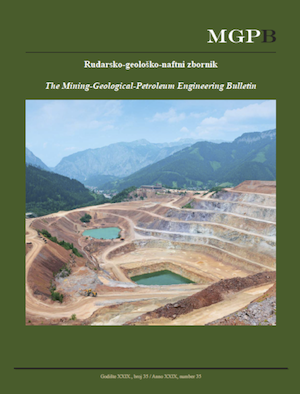Gas permeability of geosynthetic clay liners
DOI:
https://doi.org/10.17794/rgn.2017.1.2Abstract
Geosynthetic clay liners (GCL) are manufactured hydraulic barriers consisting of mineral and geosynthetic components. They belong to a group of geosynthetic products whose primary purpose is to seal and they have been used in many geotechnical and hydrotechnical applications, landfi lls and liquid waste lagoons for quite a while. They are used in landfill final cover systems to prevent the infi ltration of precipitation into the landfi ll body and the penetration of gases and liquids from the landfill into the atmosphere and environment. Laboratory and fi eld research and observations on regulated landfi lls have proven the eff ectiveness of GCL as a barrier for the infi ltration of precipitation into the landfi ll body as well as the drainage of fl uid beneath the landfill. Due to the presence of high concentrations of gases in the landfill body, there is a growing interest in determining the efficiency of GCL as a gas barrier. It was not until the last twenty years that the importance of this topic was recognized. In this article, current GCL gas permeability studies, the testing methods and test results of gas permeability in laboratory conditions are described.Downloads
Published
How to Cite
Issue
Section
License
Copyright (c) 2016 Rudarsko-geološko-naftni zbornik

This work is licensed under a Creative Commons Attribution 4.0 International License.
Creative Commons-BY
Authors who publish with this journal agree to the following terms:
In agreeing this form, you certify that:
- You read the ethical codex of the RGN zbornik available at journal web.
- You submitted work is your original work, and has not previously been published and does not include any form of plagiarism.
- You own copyright in the submitted work, and are therefore permitted to assign the licence to publish to RGN zbornik.
- Your submitted work contains no violation of any existing copyright or other third party right or any material of an obscene, libellous or otherwise unlawful nature.
- You have obtained permission for and acknowledged the source of any illustrations, diagrams or other material included in the work of which you are not the copyright owner.
- You have taken due care to ensure the accuracy of the work, and that, to the best of your knowledge, there are no false statements made within it.
- All co-authors of this submitted work are aware of, and in agreement with, the terms of this licence and that the submitted manuscript has been approved by these authors.
Publication licence
You retain copyright in your submitted work, according to journal license policy (CC-BY). By signing this form you agree that RGN zbornik may publish it under the publication licence. In summary the licence allows the following:
Anyone is free:
- To copy, distribute, display, and perform the work.
- To make derivative works.
Under the following conditions:
- The original author must always be given credit.
- The work may not be used for commercial purposes.
- If the work is altered, transformed, or built upon, the resulting work may only be distributed under a licence identical to this one.
Exceptions to the licence
In addition to publishing the work printed under the above licence, RGN zbornik will also enable the work to be visible online.
The journal editorial can change the licence rules anytime but it cannot retroactively restrict author(s) rights.


